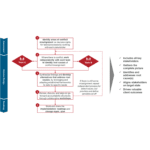What is an employee experience?
Employee experience refers to the interactions employees have with their employer, from the initial recruitment process to their daily work, the company culture, relationships with colleagues and managers, opportunities for growth and mentorship, access to resources and tools, and the physical and virtual work environment.
Employee experience encapsulates how employees feel about their jobs and the company for which they work. A positive employee experience often leads to higher engagement, satisfaction, productivity, and employee retention. Organizations often use a tool called an employee journey to define the employee experience over the course of an employee’s career.
What is an employee journey?

An employee journey is a defined path followed by incoming candidates and current employees throughout their careers. An employee journey map identifies professional and personal moments that matter. It details enabling activities such as communication, training, and coaching that an organization delivers at critical moments in an employee’s career. It also identifies career development avenues for employees. Company culture is a key consideration that shapes each stage of the employee journey.
What are moments that matter?
Moments that matter are meaningful personal and professional events and activities that shape an employee’s experience while at work. Professional examples include the first day of a job or special recognition for a significant accomplishment. Personal examples include getting a special designation or graduating from a scholastic program.
Celebrating moments that matter is an essential part of the employee journey because it affirms the significance of employee achievements. Honouring these achievements goes a long way toward making an employee feel highly valued, which increases employee satisfaction and reduces turnover.
We can help your organization:
- Determine how to build a customized path for incoming employees.
- Develop a differentiated employee experience.
- Facilitate elevated employee engagement that fosters higher productivity and longer tenure.
- Better understand what matters to employees and enable a plan to deliver it.
- Create unique approaches for the new hire onboarding process.
- Enable employee growth across the organization.
- Develop a sustained culture of appreciation to foster employee trust and commitment.
- Build a mentorship-oriented environment that accelerates employee development.
- Define high-value, achievable business outcomes.
- Improve operational efficiency and increase corporate revenue.
Our approach to employee experience
We work with you to define and develop a differentiated experience for recruits and employees, from assessing the current state of your employee experience and defining the employee value proposition to developing and implementing an employee journey map.
1. Assess current state of people, culture, and engagement
We start with a current state assessment of your organization’s people, culture, and employee engagement to understand what makes your organization tick and how it feels to work there.
During this time, we:
- Meet with frontline employees, leaders, and business partners to assess the culture and determine what elements of the desired employee experience already exist
- Review the corporate strategy and operating model.
- Evaluate scorecards and KPIs to identify potential pressure placed on employees to achieve targets and how this affects their engagement.
- Review the current employee engagement cadence, how engagement is measured, and whether there is an initiative action plan to improve on known concerns.
- Relate the employee experience to the company’s mission, vision, and values to ensure it fits into the fabric of the corporate culture.
- Based on these insights, we consider the options for building the ideal candidate and employee experience.
2. Define the employee value proposition
The employee value proposition helps attract employees to work at a company. It is your cultural differentiator and a compass to guide the employee and candidate journey. Our interactive workshops help define:
- Learning and development: Create opportunities for growth, training, mentorship, and advancement.
- Work environment: Establish the company culture, including work-life balance, flexibility, and workplace facilities.
- Rewards and recognition: Determine how you will reward achievement and recognize moments that matter.
- Company values and purpose: Define the shared purpose that drives everyone in your organization.
- Compensation and benefits: Collaborate with your human resources team to ensure your compensation is market-competitive and your benefit packages are a differentiator.
-
Define an employee journey map to capture the recruitment and employee experience
We break down each phase of the employee journey and connect them in a map to show how candidates and employees progress through their experience. While there are common elements across each company’s employee journey, each experience is unique to the company. These include:
- Hiring: Create a positive impression of the company during the recruitment process. Use assessment tools that are easy and enjoyable to use. Communicate transparently and keep candidates informed throughout the recruitment process.
- Onboarding: Establish a structured onboarding and mentorship process to introduce the company culture and values. Inform new hires about policies, set up technology and tools, and define role and responsibilities.
- Integration: Establish performance expectations and implement ongoing support systems.
- Training and development: Provide opportunities for training and development and establish measures for goal setting and progress tracking.
- Engagement and retention: Implement a formal recognition and rewards program and establish regular feedback mechanisms, such as performance reviews.
- Career pathing: Define roles and reporting structures. Detail how employees can progress and advance throughout the organization.
- Transitions and exits: Create a process for employees transitioning to new roles and departments within the organization and establish an offboarding process for employees leaving the organization, including exit interviews to gather feedback about the employee experience.
- Continuous improvement: Seek regular feedback from team members to determine what is going well and how to continuously improve the employee experience.
-
Create an implementation roadmap
Once we create a journey map for the employee experience, we work with you to create an implementation roadmap so that you can roll out the changes across your organization. The roadmap summarizes the following:
- Specific tasks and associated dependencies to implement in each journey map phase and task owners best suited to execute the work.
- Potential risks associated with each task and how to mitigate them.
- A timeline for implementing each journey map phase will be implemented, including durations.
- Defined milestones will be created to track and celebrate progress.
Why choose Burnie Group
Organizations that work with us to elevate and differentiate their employee experience receive:
- Expert guidance to create a meaningful and rewarding employee experience.
- A proven approach to employee journey mapping, tailored to meet your needs.
- Actionable analysis, insights, and recommendations.
- New ideas to build on the successful elements of your employee experience.
- Quantified outcomes to improve cost, efficiency, and revenue.
- High value for your financial investment.
Testimonials
"Burnie Group developed an innovative approach to define and shape an ideal employee experience. They challenged us to see an employee’s entry into the bank from two perspectives (pre and post-hire), with each requiring its own unique journey. Together, we built an employee experience that we believe differentiates us in the marketplace. Thank you, BG!"
Our people & organization insights
Our people & organization leaders
Discover how we can help your organization improve its employee experience.
CONTACT US







